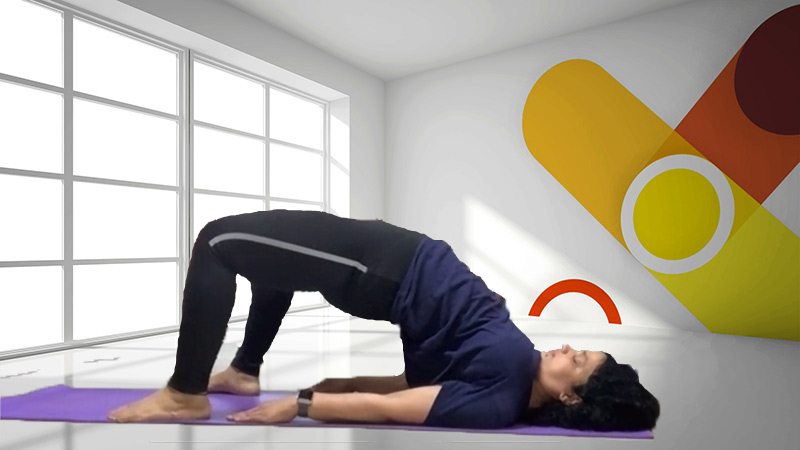Table of Contents
Setu Bandhasana – Bridge Pose Yoga Benefits
Setu Bandhasana (सेतुबंधासन – Setu Bandhasana in Hindi) or The Bridge Pose is a backward bend pose and can be best recommended for the strengthening of back muscles. This Yoga Asana gives immediate relief to the people suffering from lower back pain. The word Setu Bandhasana is made up of three Sanskrit words viz. “Setu” meaning Bridge; “Bandha” meaning lock; and “Asana”, which means posture. The final pose of this Yogasana gives the impression of a bridge and hence the name Bridge Pose.
How To Do Setu Bandhasana (Bridge Pose)
- Spread a Yoga Mat and lie flat on the back.
- Bend the knees and place the soles of the feet flat on the mat, 10 to 12 inches away from the buttocks.
- The feet and the knees should be kept at hip-width apart or more than that to maintain the balance of the body.
- Keep the arms by the sides with palms facing down.
- This is the starting position.
- While inhaling, raise the buttocks and arch the back upward.
- Raise the navel as high as possible but without straining.
- Keep the feet flat on the floor.
- This is the final position.
- Become aware of the stretch in the back muscles and in the spine.
- Take two to three long and deep breaths in the final pose with the awareness in the spine and back muscles.
- While exhaling, release the pose.
- Let upper back first touch the floor, then lower back and in the end, allow the buttocks to rest on the floor.
- Feel and acknowledge the deep relaxation induced in the spine.
Setu Bandhasana Contraindications
People suffering from cervical disorders should either avoid this asana or should do it under the guidance of an expert Yoga Teacher.
Bridge Pose (Setu Bandhasana) Benefits
- Bridge Pose in Yoga strengthens the back muscles and hence is very good for people recovering from a slipped disc.
- This Yogasana gives immediate relief to people suffering from back pain particularly lower back pain.
- Bridge Pose improves the flexibility of the spine.
- This Yoga Exercise strengthens the muscles of the shoulders, legs, and arms.
- Setu Bandhasana opens up the chest allowing the practitioner to inhale deeply. Plenty of oxygen is supplied to the alveoli of the lungs.
- Stretch provided to the abdomen helps the reproductive organs to become healthy.
- Setu Bandhasana helps improve digestion.
Setu Bandhasana Sequence
Setu Bandhasana is a backward bend pose and will give the best result if practiced immediately after the Yogasanas of Abdominal Group like Pawanmuktasana, Naukasana, or Padotthanasana.
Setu Bandhasana may be performed before Yoga Nidra in order to attain a deeper state of relaxation.
Best Series Of Asanas Recommended For Lower Back Pain
People suffering from lower back pain should practice
- Makarasana,
- Bhujangasana,
- Shalabhasana, and
- Pawanmuktasana in combination with Setubandhasana to get lower back pain relief.
Kandharasana & Setu Bandhasana – The Difference
There is a difference between Kandharasana and Setu Bandhasana.
- The first major difference in both the asanas is that in Kandharasana the practitioner should grasp the ankles with the hands. In Setu Bandhasana, the palms are glued to the floor and add to the support of raise back.
- In Kandharasana, the soles of the feet are so placed that heels touch the buttocks. In Setu Bandhasana, the heels are 10 to 12 inches away from the buttocks.
- In Kandharasana, Shoulders play a major role in supporting the raised back and bears the weight of the body along with the arms, head, heels, and sole. In Setu Bandhasana, the role of shoulders in supporting the raised back is lesser.
- The major benefit in Kandharasana is related to rounded shoulders, lungs, digestion, and alignment of the spine. In Setu Bandhasana, the main benefit is back pain relief.

